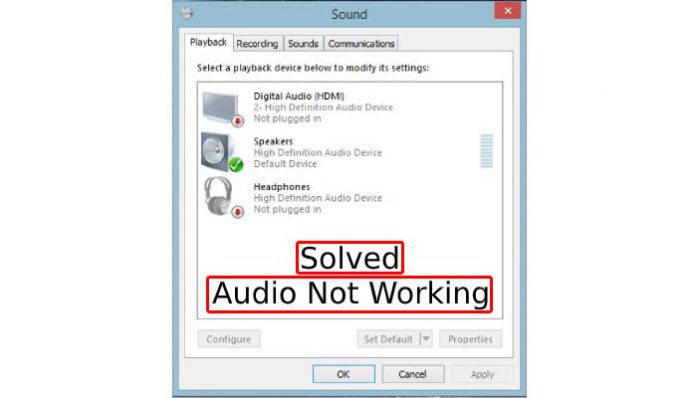I faced a lot of issues when it comes to the audio section. I always had a problem, when Realtek audio manager doesn’t show up on the screen, and other errors. We are going to explore several solutions that will assist Windows administrators in solving the Audio not working problem. I recommend trying the number of solutions that I’m about to share, and then decide whether you got a serious motherboard chip-level problem or not.
Why Audio is not working on my Computer?
Assuming the scenario might sound inaccurate, but it has to be one of the reasons below.
- Faulty 3.5mm jack.
- Corrupted drivers.
- Damaged motherboard level audio chipset.
- Incompatible drivers or undetected hardware changes.
- Wrong configuration.
Solving the problem might consume a little bit of your precious time.
How do I fix Sound not working in Windows 10
Expensive gaming computers integrated with multiple sound devices, and it had happened to me when I was streaming on YouTube. Modern monitors, Graphics card, and mother sound card create different options such as to monitor 3.5mm jack, front 3.5mm jack, and a rear 3.5mm jack. You have to select the right sound output, and I will show you in simple steps.
- In the taskbar, Tap on the sound icon.
- The troubleshooter will open, and it will display the status, and then click on “NEXT” to go ahead.
- According to the troubleshooter,
- My headset is not plugged in, which is true in my case. The motherboard audio jack might have worn off, or headset audio jack might have died.
- Hardware changes are not detected yet, so restart the computer for updated configuration.
Despite the outcome, I recommend testing the headset first and confirm whether the 3.5mm audio jack has reached its expiration date. In order to confirm, you can connect the headset to another computer to confirm 3.5mm pin failure, and the front audio jacks come in handy to confirm motherboard audio jack failure.
Configuration of Realtek HD Manager
Realtek is a global manufacturer in audio chipset and every computer that I had in my lifetime integrated with Realtek Audio. I’m well-aware of the user interface and options that the global manufacturer offered to the music lovers. Configuring the device is a difficult task for a beginner and a non-technological person.
- Press Windows key + S and then type Control Panel > Hardware & Sound > HD Manager. The exact location is “Control Panel\Hardware and Sound” and enters in the file explorer.
- Click on the gear icon in Realtek audio manager, and it remains the same on HD Audio managers dated from 10 years old chipsets.
- Tap on the “enable auto popup dialog when a device has been plugged in” and then click on “OK” to complete the process.
- Connect the headphone, and select the output based on the type of device.
Remove the connected headphone and then reconnect the device, and it will prompt a dialog. The option will appear every time; you connect a new device or an old audio device. Make sure to select the headphone or speaker’s profile because it will reflect the output.
Troubleshoot
In Windows 8 or above running PC’s come with an advanced inbuilt function that enables the administrators to check the problem. By using a troubleshooter, you can find out which function is not working correctly. Allow me to guide the readers through it and then show you the next-level solution.
- Go to settings and click on “Update & Security.”
- Click on the troubleshooter to explore more options, and then scroll down until you find “playing audio” function. Click on the option and then select “troubleshooter.”
- The troubleshooter checks the audio driver, hardware, and connected devices, and more. It will suggest or fix the problem and make sure to follow the solution that troubleshooter offers.
Frying the audio chipset on the motherboard is rare, and it shouldn’t happen randomly. We are going to try the ultimate driver update and then check whether the newer updated drivers are causing the problem or not.
Update or Install Motherboard Drivers
I recommend updating the audio drivers using a manual method or Windows update. However, I also recommend downgrading the audio modules, so it can reach the true potential that the motherboard manufacturer shipped with it. Allow me to show you how you can download official drivers from the manufacturer’s website and install them.
The new installation will replace the old installation file or overwrites the old installation files. Do not worry about the 10-years old manufactured motherboard because I’m suggesting the solution for all motherboards. I tested the method on 2007 manufactured motherboard and modern 2018 model as well, and it works on newer or older generation hardware.
Also, repeat the process by uninstalling the audio driver from the Device Manager. By uninstalling from the Device Manager, it will remove old installation files from the system files, and create a space for newer system files.
Bottom Line
Anyone can fix the sound issue in windows 10 by following the above solutions. It’s not common for Windows administrators to face the unique situation, so I recommend creating a new thread on Microsoft forums. Make sure to provide sufficient information about hardware, software, and occurred problem in the thread to solve the problem.


